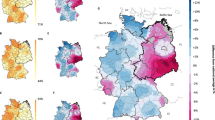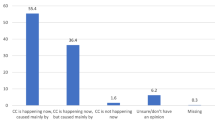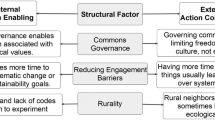Abstract
Critics have argued that the evidence of an association between climate change and conflict is flawed because the research relies on a dependent variable sampling strategy1,2,3,4. Similarly, it has been hypothesized that convenience of access biases the sample of cases studied (the ‘streetlight effect’5). This also gives rise to claims that the climate–conflict literature stigmatizes some places as being more ‘naturally’ violent6,7,8. Yet there has been no proof of such sampling patterns. Here we test whether climate–conflict research is based on such a biased sample through a systematic review of the literature. We demonstrate that research on climate change and violent conflict suffers from a streetlight effect. Further, studies which focus on a small number of cases in particular are strongly informed by cases where there has been conflict, do not sample on the independent variables (climate impact or risk), and hence tend to find some association between these two variables. These biases mean that research on climate change and conflict primarily focuses on a few accessible regions, overstates the links between both phenomena and cannot explain peaceful outcomes from climate change. This could result in maladaptive responses in those places that are stigmatized as being inherently more prone to climate-induced violence.
This is a preview of subscription content, access via your institution
Access options
Access Nature and 54 other Nature Portfolio journals
Get Nature+, our best-value online-access subscription
$29.99 / 30 days
cancel any time
Subscribe to this journal
Receive 12 print issues and online access
$209.00 per year
only $17.42 per issue
Buy this article
- Purchase on Springer Link
- Instant access to full article PDF
Prices may be subject to local taxes which are calculated during checkout


Similar content being viewed by others
References
Buhaug, H. et al. One effect to rule them all? A comment on climate and conflict. Climatic Change 127, 391–397 (2014).
Buhaug, H. Climate–conflict research: some reflections on the way forward. WIREs Clim. Change 6, 269–275 (2015).
Gemenne, F., Barnett, J., Adger, W. N. & Dabelko, G. Climate and security: evidence, emerging risks, and a new agenda. Climatic Change 123, 1–9 (2014).
Raleigh, C., Linke, A. & O´Loughlin, J. Extreme temperatures and violence. Nat. Clim. Change 4, 76–77 (2014).
Hendrix, C. S. The streetlight effect in climate change research on Africa. Glob. Environ. Change 43, 137–147 (2017).
Barnett, J. The price of peace (is eternal vigilance): a cautionary editorial essay on climate geopolitics. Climatic Change 96, 1–6 (2009).
Ide, T. Critical geopolitics and school textbooks: the case of environment–conflict links in Germany. Polit. Geogr. 55, 61–70 (2016).
Verhoeven, H. Gardens of Eden or Hearts of Darkness? The genealogy of discourses on environmental insecurity and climate wars in Africa. Geopolitics 19, 784–805 (2014).
McDonald, M. Discourses of climate security. Polit. Geogr. 33, 42–51 (2013).
Ide, T. Research methods for exploring the links between climate change and conflict. WIREs Clim. Change 8, 1–14 (2017).
O’Loughlin, J., Linke, A. M. & Witmer, F. D. W. Modeling and data choices sway conclusions about climate–conflict links. Proc. Natl Acad. Sci. USA 111, 2054–2055 (2014).
Hsiang, S., Burke, M. & Miguel, E. Quantifying the influence of climate on human conflict. Science 341, 1–14 (2013).
Hsiang, S. & Burke, M. Climate, conflict, and social stability: what does the evidence say? Climatic Change 123, 39–55 (2014).
Kelley, C. P., Mohtadib, S., Cane, M. A., Seager, R. & Kushnir, Y. Climate change in the Fertile Crescent and implications of the recent Syrian drought. Proc. Natl Acad. Sci. USA 112, 3241–3246 (2015).
De Juan, A. Long-term environmental change and geographical patterns of violence in Darfur, 2003–2005. Polit. Geogr. 45, 22–33 (2015).
Feitelson, E. & Tubi, A. A main driver or an intermediate variable? Climate change, water and security in the Middle East. Glob. Environ. Change 44, 39–48 (2017).
Hartmann, B. Rethinking climate refugees and climate conflict: rhetoric, reality and the politics of policy discourse. J. Int. Dev. 22, 233–246 (2010).
Dalby, S. Recontextualising violence, power and nature: the next twenty years of critical geopolitics? Polit. Geogr. 29, 280–288 (2010).
Ford, J. D., Berrang-Ford, L. & Paterson, J. A systematic review of observed climate change adaptation in developed nations. Climatic Change 106, 327–336 (2011).
Downes, B. J., Miller, F., Barnett, J., Glaister, A. & Ellemor, H. How do we know about resilience? An analysis of empirical research on resilience, and implications for interdisciplinary praxis. Environ. Res. Lett. 8, 1–9 (2013).
IPCC Climate Change 2014: Impacts, Adaptation, and Vulnerability (eds Field, C. B. et al.) (Cambridge Univ. Press, 2014).
Melander, E., Pettersson, T. & Themnér, L. Organized violence, 1989–2015. J. Peace Res. 53, 727–742 (2016).
Country Index Exposure 2015 (ND-GAIN, 2016); http://index.gain.org/ranking/vulnerability/exposure
Kreft, S., Ecksetin, D. & Melchior, I. Global Climate Risk Index 2017 (Germanwatch, 2017).
Benjaminsen, T., Alinon, K., Buhaug, H. & Buseth, J. T. Does climate change drive land-use conflict in the Sahel? J. Peace Res. 49, 97–111 (2012).
Bernauer, T. & Gleditsch, N. P. New event data in conflict research. Int. Interact. 38, 375–381 (2012).
Expanding research views. Nat. Clim. Change 7, 229 (2017).
Gleditsch, N. P. Armed conflict and the environment: a critique of the literature. J. Peace Res. 35, 381–400 (1998).
Adano, W., Dietz, T., Witsenburg, K. M. & Zaal, F. Climate change, violent conflict and local institutions in Kenya’s dryland. J. Peace Res. 49, 65–80 (2012).
Fincher, R., Barnett, J. & Graham, S. Temporalities in adaptation to sea-level rise. Ann. Assoc. Am. Geogr. 105, 263–273 (2015).
Higgins, J. P. T. & Green, S. (eds) Cochrane Handbook for Systematic Reviews of Interventions version 5.1.0 (Cochrane Collaboration, London, 2011).
Ford, J. D. & Pearce, T. What we know, do not know, and need to know about climate change vulnerability in the western Canadian Arctic: a systematic literature review. Environ. Res. Lett. 5, 1–9 (2010).
Zhang, D. D. et al. The causality analysis of climate change and large-scale human crisis. Proc. Natl Acad. Sci. USA 108, 17296–17301 (2011).
Scheffran, J., Ide, T. & Schilling, J. Violent climate or climate of violence? Concepts and relations with focus on Kenya and Sudan. Int. J. Human. Rights 18, 366–387 (2014).
Maystadt, J. F. & Ecker, O. Extreme weather and civil war: does drought fuel conflict in Somalia through livestock price shocks? Am. J. Agric. Econ. 96, 1157–1182 (2014).
Theisen, O. M. Climate clashes? Weather variability, land pressure, and organized violence in Kenya, 1989-2004. J. Peace Res. 49, 81–96 (2012).
Nardulli, P. F., Peyton, B. & Bajjalieh, J. Climate change and civil unrest: the impact of rapid-onset disasters. J. Confl. Resolut. 59, 310–335 (2015).
Selby, J. Positivist climate conflict research: a critique. Geopolitics 19, 829–856 (2014).
Hartmann, B. Converging on disaster: climate security and the malthusian anticipatory regime for Africa. Geopolitics 19, 757–783 (2014).
Salehyan, I. Climate change and conflict: making sense of disparate findings. Polit. Geogr. 43, 1–5 (2014).
World Populations Prospects: The 2017 Revision (United Nations, 2017).
Employment in Agriculture (% of Total Employment) (International Labour Organization, 2017); https://data.worldbank.org/indicator/SL.AGR.EMPL.ZS?locations=AL
World Development Indicators: Contribution of the Agricultural Sector to GDP (World Bank, 2017); https://data.worldbank.org/data-catalog/world-development-indicators
Ide, T. et al. On exposure, vulnerability and violence: spatial distribution of risk factors for climate change and violent conflict across Kenya and Uganda. Polit. Geogr. 43, 68–81 (2014).
Acknowledgements
This research was completed with support from the Australian–American Fulbright Commission, the German Research Foundation (DFG) project ID80/2-1 and the Australian Research Council project FT120100208.
Author information
Authors and Affiliations
Contributions
C.A., T.I., J.B. and A.D. designed the research, analysed the results and wrote the paper. C.A. performed the systematic literature review. A.D. and T.I. conducted the statistical analysis.
Corresponding author
Ethics declarations
Competing interests
The authors declare no competing financial interests.
Additional information
Publisher’s note: Springer Nature remains neutral with regard to jurisdictional claims in published maps and institutional affiliations.
Supplementary information
Supplementary Information
Supplementary Tables 1–3 and Supplementary Datasets 1–2
Supplementary Dataset 3
Coding decisions for articles under consideration
Rights and permissions
About this article
Cite this article
Adams, C., Ide, T., Barnett, J. et al. Sampling bias in climate–conflict research. Nature Clim Change 8, 200–203 (2018). https://doi.org/10.1038/s41558-018-0068-2
Received:
Accepted:
Published:
Issue Date:
DOI: https://doi.org/10.1038/s41558-018-0068-2
This article is cited by
-
Climate change and conflict
Nature Reviews Earth & Environment (2023)
-
Climatic factors as drivers of migration: a review
Environment, Development and Sustainability (2023)
-
Exploring the effects of climate change and government stability on internal conflicts: evidence from selected sub-Saharan African countries
Environmental Science and Pollution Research (2023)
-
What climate? The different meaning of climate indicators in violent conflict studies
Climatic Change (2023)
-
Climate change and armed conflicts in Africa: temporal persistence, non-linear climate impact and geographical spillovers
Economia Politica (2023)



